Abstract
To investigate factors associated with pesticide-related visits to health care providers (i.e., doctor or hospital visits), responses to self-administered questionnaires received from 35,879 licensed restricted-use pesticide applicators participating in the Agricultural Health Study were analyzed. (In Iowa, applicators are actually certified, whereas in North Carolina they are licensed; for ease of reference, the term license will be used for both states in this paper.) The cohort reported a total of more than 10.9 million pesticide-application days. These applications were associated with one or more pesticide-related health care visits by 2,214 applicators (7.0% of the applicator cohort for whom health care visit data were available). The odds of a pesticide-related health care visit were increased for commercial applicators compared to private applicators [odds ratio (OR = 1.77; 95% confidence interval (CI), 1.52-2.06) and for applicators who used insecticides 70 times or more in their lifetime compared to those who used insecticides less frequently (OR = 1.43; CI, 1.26-1.63). After adjusting for the number of applications in a logistic regression model, significantly higher odds of health care visits were observed among North Carolina applicators compared to Iowa applicators (OR = 1.35; CI, 1.17-1.52), among applicators who mixed their own pesticides (OR = 1.65; CI, 1. 22-2.23), and among applicators who personally repaired their pesticide application equipment at least once per year (OR = 1.12; CI, 1.06-1.25). Significantly lower odds were found among female versus male applicators (OR = 0.68; CI, 0.46-0.99) and among applicators who graduated from high school versus those who did not (OR = 0.82; CI, 0.71-0.94 for high school graduates and OR = 0.79; CI, 0.68-0.91 for those with at least some college). Several methods of pesticide application to crops, seed, or stored grain were also associated with significantly elevated odds ratios of health care visits. These observations suggest that several steps can be taken to reduce the number of health care visits resulting from occupational exposure to pesticides. The implications of this pattern of pesticide-related health care visits may have etiologic implications for cancer and other chronic diseases.
Full text
PDF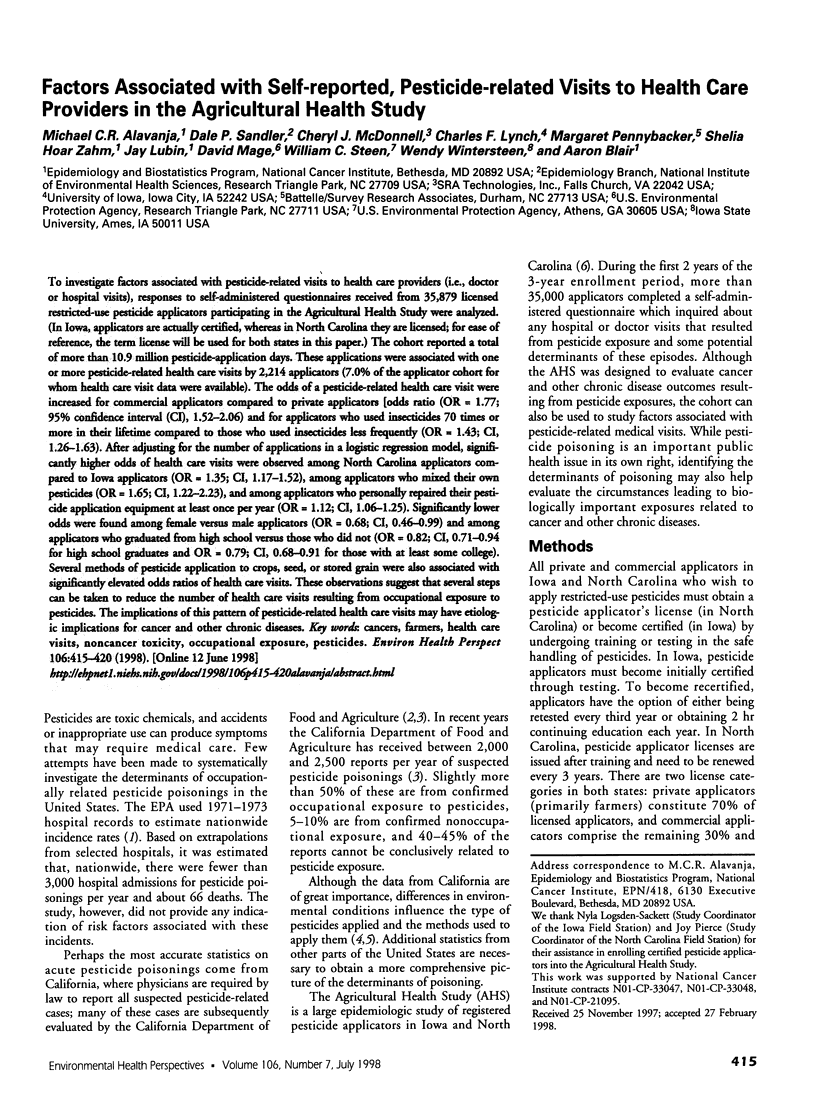
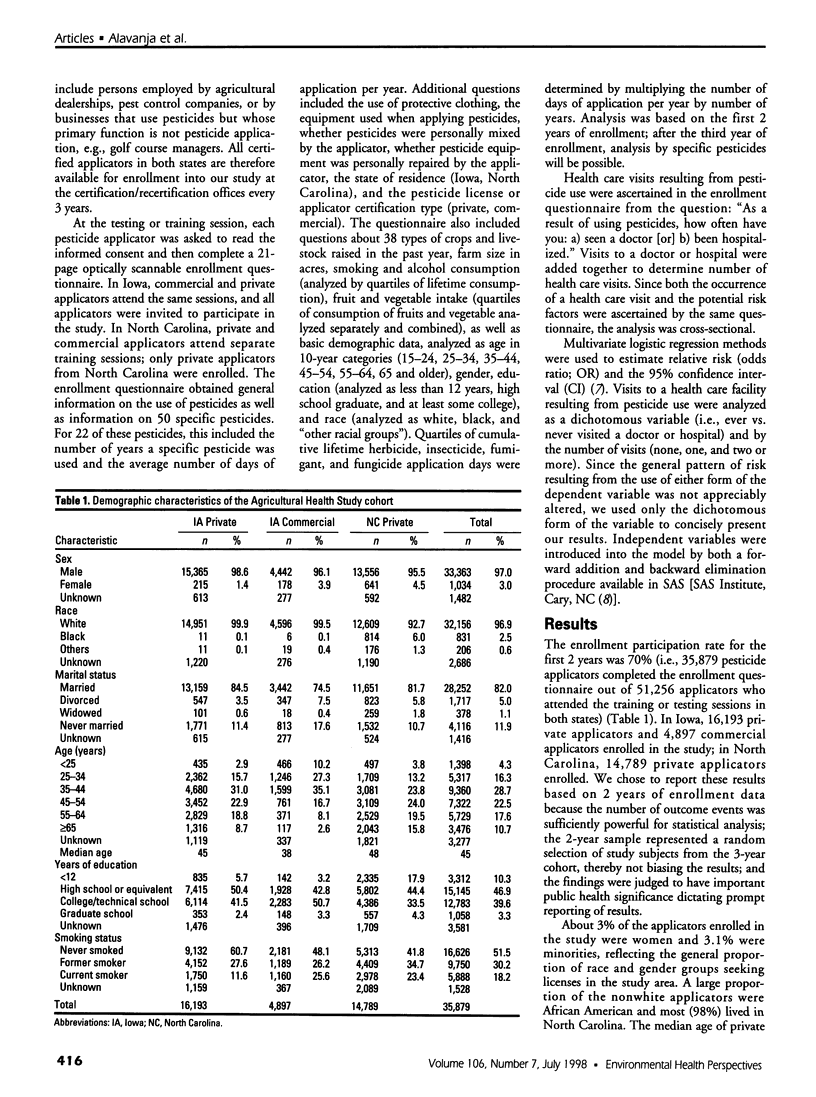
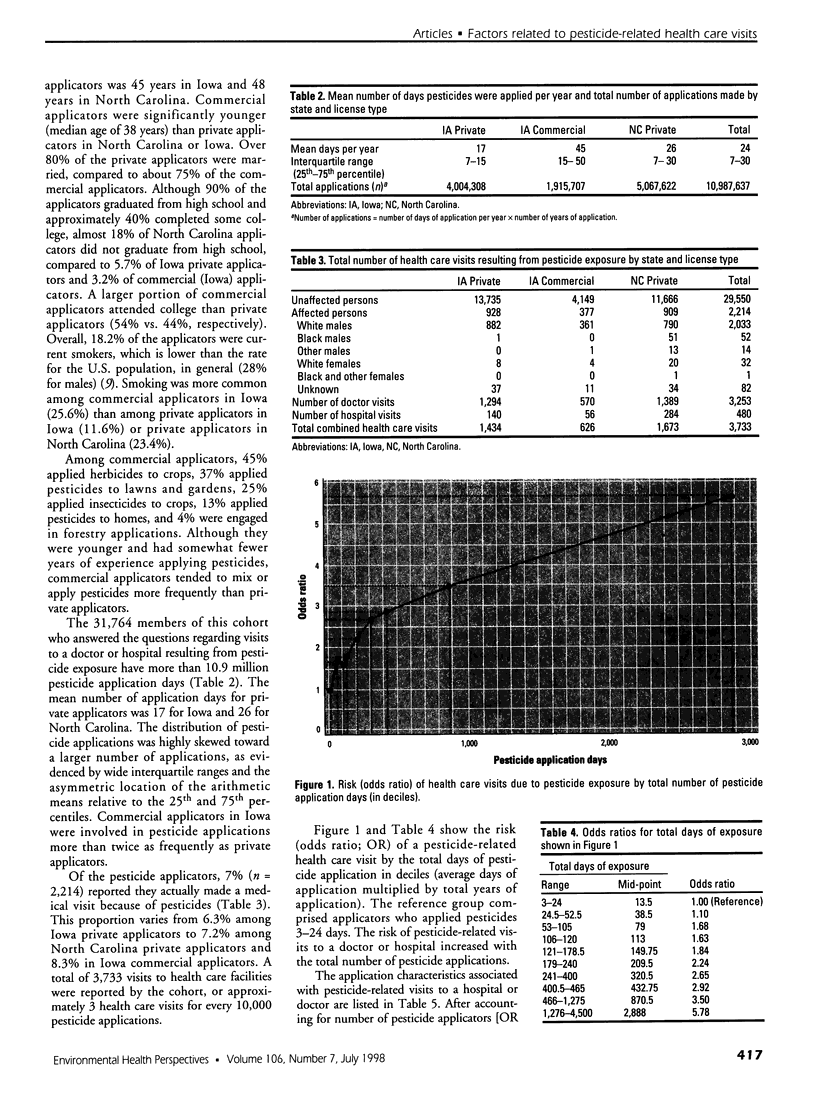
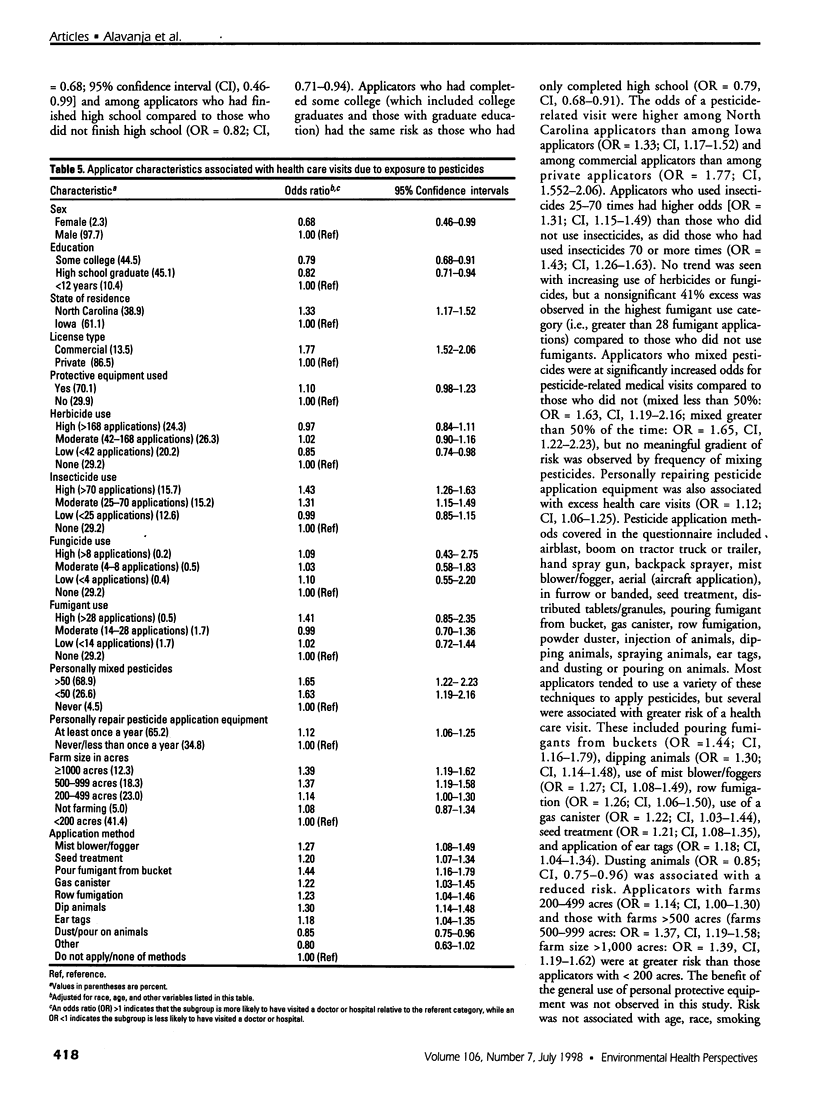
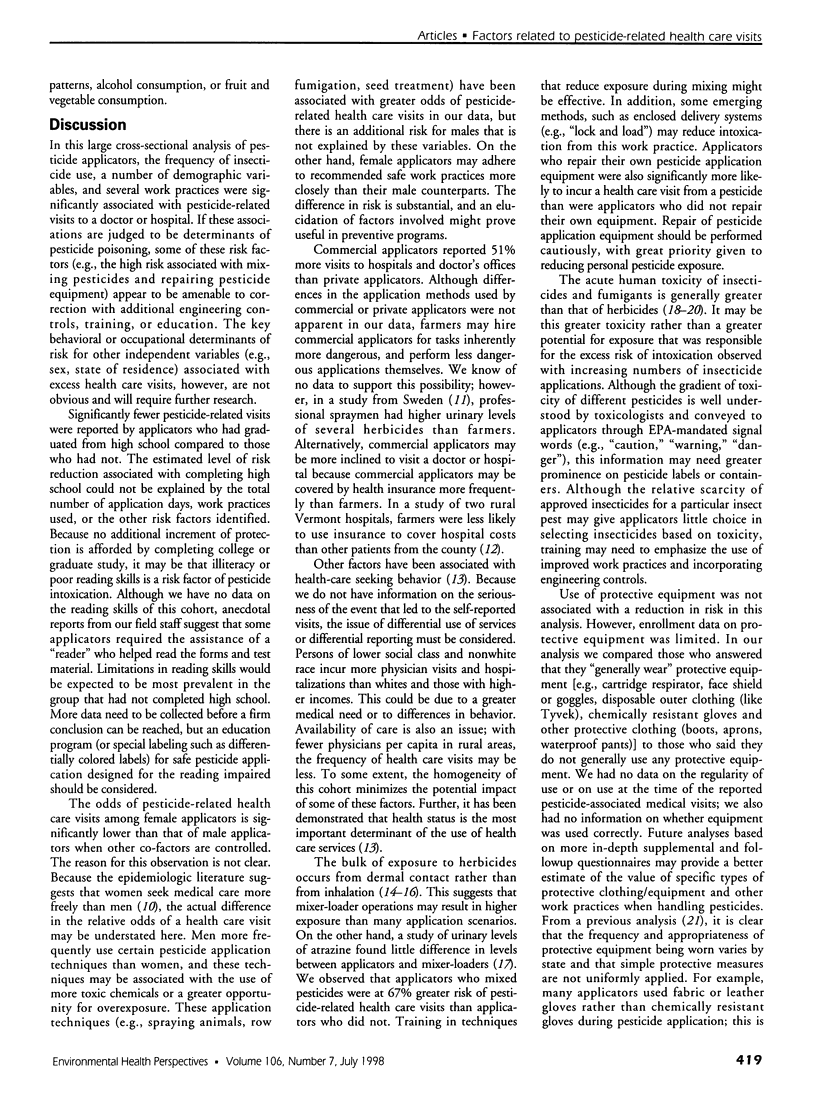
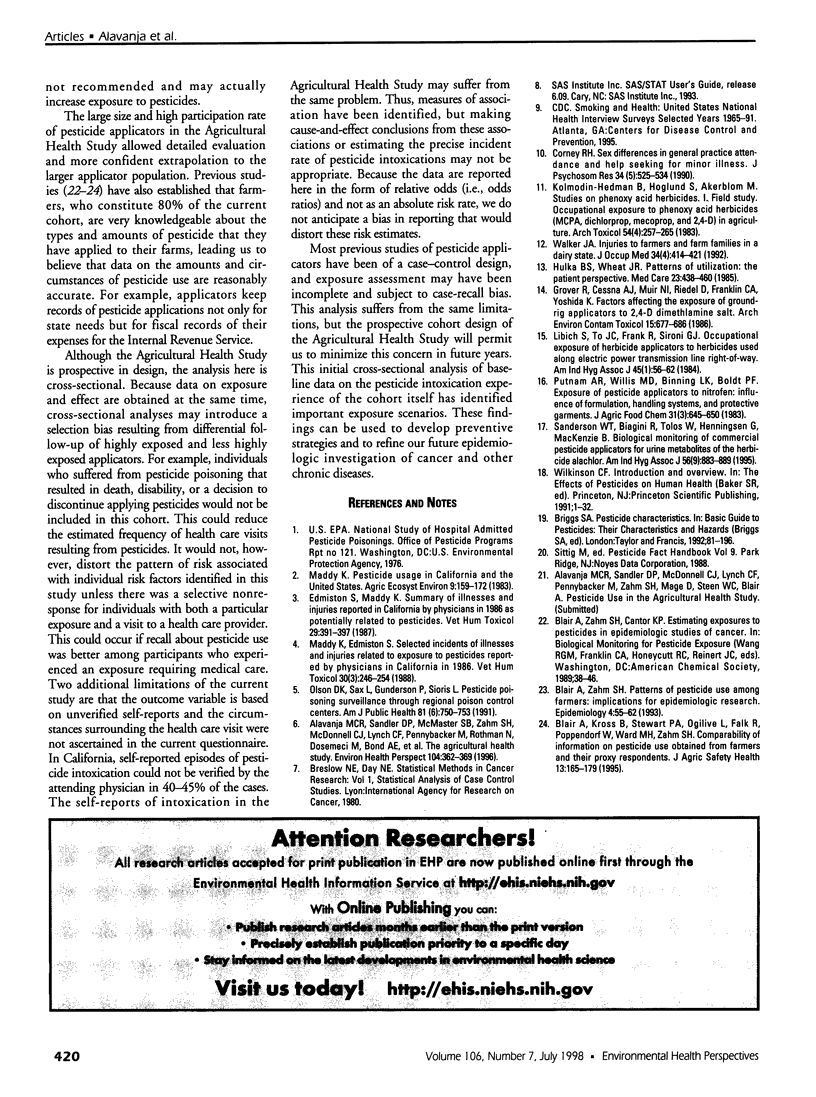
Images in this article
Selected References
These references are in PubMed. This may not be the complete list of references from this article.
- Alavanja M. C., Sandler D. P., McMaster S. B., Zahm S. H., McDonnell C. J., Lynch C. F., Pennybacker M., Rothman N., Dosemeci M., Bond A. E. The Agricultural Health Study. Environ Health Perspect. 1996 Apr;104(4):362–369. doi: 10.1289/ehp.96104362. [DOI] [PMC free article] [PubMed] [Google Scholar]
- Blair A., Zahm S. H. Patterns of pesticide use among farmers: implications for epidemiologic research. Epidemiology. 1993 Jan;4(1):55–62. doi: 10.1097/00001648-199301000-00011. [DOI] [PubMed] [Google Scholar]
- Corney R. H. Sex differences in general practice attendance and help seeking for minor illness. J Psychosom Res. 1990;34(5):525–534. doi: 10.1016/0022-3999(90)90027-2. [DOI] [PubMed] [Google Scholar]
- Edmiston S., Maddy K. T. Summary of illnesses and injuries reported in California by physicians in 1986 as potentially related to pesticides. Vet Hum Toxicol. 1987 Oct;29(5):391–397. [PubMed] [Google Scholar]
- Grover R., Cessna A. J., Muir N. I., Riedel D., Franklin C. A., Yoshida K. Factors affecting the exposure of ground-rig applicators to 2,4-D dimethylamine salt. Arch Environ Contam Toxicol. 1986 Nov;15(6):677–686. doi: 10.1007/BF01054915. [DOI] [PubMed] [Google Scholar]
- Hulka B. S., Wheat J. R. Patterns of utilization. The patient perspective. Med Care. 1985 May;23(5):438–460. doi: 10.1097/00005650-198505000-00009. [DOI] [PubMed] [Google Scholar]
- Kolmodin-Hedman B., Höglund S., Akerblom M. Studies on phenoxy acid herbicides. I. Field study. Occupational exposure to phenoxy acid herbicides (MCPA, dichlorprop, mecoprop and 2,4-D) in agriculture. Arch Toxicol. 1983 Dec;54(4):257–265. doi: 10.1007/BF01234478. [DOI] [PubMed] [Google Scholar]
- Libich S., To J. C., Frank R., Sirons G. J. Occupational exposure of herbicide applicators to herbicides used along electric power transmission line right-of-way. Am Ind Hyg Assoc J. 1984 Jan;45(1):56–62. doi: 10.1080/15298668491399370. [DOI] [PubMed] [Google Scholar]
- Maddy K. T., Edmiston S. Selected incidents of illnesses and injuries related to exposure to pesticides reported by physicians in California in 1986. Vet Hum Toxicol. 1988 Jun;30(3):246–254. [PubMed] [Google Scholar]
- Olson D. K., Sax L., Gunderson P., Sioris L. Pesticide poisoning surveillance through regional poison control centers. Am J Public Health. 1991 Jun;81(6):750–753. doi: 10.2105/ajph.81.6.750. [DOI] [PMC free article] [PubMed] [Google Scholar]
- Putnam A. R., Willis M. D., Binning L. K., Boldt P. F. Exposure of pesticide applicators to nitrofen: influence of formulation, handling systems, and protective garments. J Agric Food Chem. 1983 May-Jun;31(3):645–650. doi: 10.1021/jf00117a042. [DOI] [PubMed] [Google Scholar]
- Sanderson W. T., Biagini R., Tolos W., Henningsen G., MacKenzie B. Biological monitoring of commercial pesticide applicators for urine metabolites of the herbicide alachlor. Am Ind Hyg Assoc J. 1995 Sep;56(9):883–889. doi: 10.1080/15428119591016511. [DOI] [PubMed] [Google Scholar]
- Waller J. A. Injuries to farmers and farm families in a dairy state. J Occup Med. 1992 Apr;34(4):414–421. [PubMed] [Google Scholar]



